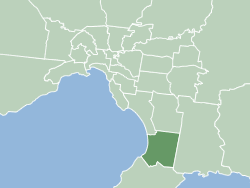
The Shire of Mornington Peninsula is a local government area in southeastern Metropolitan Melbourne, Victoria, Australia. It is located to the south of the Melbourne City Centre. It has an area of 724 square kilometres and in June 2018 it had a population of 165,822.

The City of Frankston is a local government area (LGA) in Victoria, Australia in the southern suburbs of Melbourne. It has an area of 130 square kilometres, and in June 2018, the City of Frankston recorded a population of 141,845.

The Mornington Peninsula is a peninsula located south of Melbourne, Victoria, Australia. It is surrounded by Port Phillip to the west, Western Port to the east and Bass Strait to the south, and is connected to the mainland in the north. Geographically, the peninsula begins its protrusion from the mainland in the area between Pearcedale and an area north of Frankston. The area was originally home to the Mayone-bulluk and Boonwurrung-Balluk clans and formed part of the Boonwurrung nation's territory prior to European settlement.

Pearcedale is a township and coastal rural locality in Victoria, Australia, 49 km south-east of Melbourne's Central Business District, located within the City of Casey and the Shire of Mornington Peninsula local government areas. Pearcedale recorded a population of 3,867 at the 2021 census.

Carrum Downs is a suburb in Melbourne, Victoria, Australia, 36 km south-east of Melbourne's Central Business District, located within the City of Frankston local government area. Carrum Downs recorded a population of 21,976 at the 2021 census.

Frankston is a city in Melbourne, Victoria, Australia, 41 km (25 mi) south-east of Melbourne's Central Business District, located within the City of Frankston local government area. Frankston recorded a population of 37,331 at the 2021 census.

Carrum is a suburb in Melbourne, Victoria, Australia, 33 km (21 mi) south-east of Melbourne's Central Business District, located within the City of Kingston local government area. Carrum recorded a population of 4,239 at the 2021 census.

The Mornington Peninsula Freeway is a freeway in Melbourne, Victoria, Australia, that provides a link from south-eastern suburban Melbourne to the Mornington Peninsula. Whilst the entire freeway from Dingley Village to Rosebud is declared by VicRoads as the Mornington Peninsula Freeway, the section between EastLink in Carrum Downs and Moorooduc Highway in Moorooduc is locally and commonly known as Peninsula Link. The entire freeway corridor bears the designation M11.

The Frankston Football Club, nicknamed the Dolphins, is an Australian rules football club based in Frankston, Victoria. The club, formed in 1887, has played in the Victorian Football Association/League almost continuously since 1966.
The Geelong Field Naturalists Club (GFNC) is an Australian regional amateur scientific natural history and conservation society which was founded in 1961. It is based in Geelong, Victoria, with the aims of:
The Western Australian Naturalists' Club (WANC), founded in Perth, Western Australia, in 1924, is one of the oldest conservation groups in Australia. It caters for those interested in all areas of natural history and conservation in Western Australia through a program of excursions, meetings, workshops and social events.
Stanley Robert Mitchell was an Australian commercial metallurgist as well as an amateur mineralogist and ethnologist.

Thelymitra antennifera, commonly called the rabbit-eared sun orchid, lemon-scented sun orchid or vanilla orchid is a species of orchid which is native to Western Australia, South Australia and Victoria and northern parts of Tasmania.

The Frankston Bombers Football Netball Club, nicknamed the Bombers, is an Australian rules football and netball club based in the southeastern region of Victoria, Australia. The football squad competes in the Mornington Peninsula Nepean Football League (MPNFL). Frankston has been responsible for the development of Australian football on the Mornington Peninsula since 1887.

Peta Jan Murphy was an Australian politician. She was a member of the House of Representatives from 2019 until her death in 2023, representing the Victorian seat of Dunkley for the Australian Labor Party (ALP).
The Queensland Naturalists' Club Inc. was founded in Queensland as the Queensland Field Naturalists Club in 1906 to encourage the study, appreciation and preservation of Queensland’s flora and fauna and its environments. It has been known as the Queensland Naturalists Club from 1922. The Queensland Gould League of Bird Lovers joined the club in 1922. It organises field trips and excursions. The club is a member of the Australian Naturalists' Network.
The Castlemaine Field Naturalists Club (CFNC) is an Australian regional natural history society dedicated to the study, appreciation and conservation of the natural environment in the Castlemaine region of Victoria. Founded in 1976, the CFNC has played a pivotal role in promoting environmental awareness and scientific enquiry within the Castlemaine community.
The Latrobe Valley Field Naturalists Club is an Australian regional scientific natural history and conservation society. It is based in the Latrobe Valley in Victoria and draws members from across western, central and southern Gippsland.
The Field Naturalists' Club of Ballarat (FNCB) is an Australian regional scientific natural history and conservation society. The club was founded in 1952 (a continuation of the Field Club and Science Society) and is located in Ballarat, Victoria.
The Bendigo Field Naturalists Club (BFNC) is an Australian regional scientific natural history society, dedicated to the study, appreciation and conservation of the natural environment. It is located in Bendigo, in central Victoria and focuses on the native biodiversity of the Bendigo Valley.











